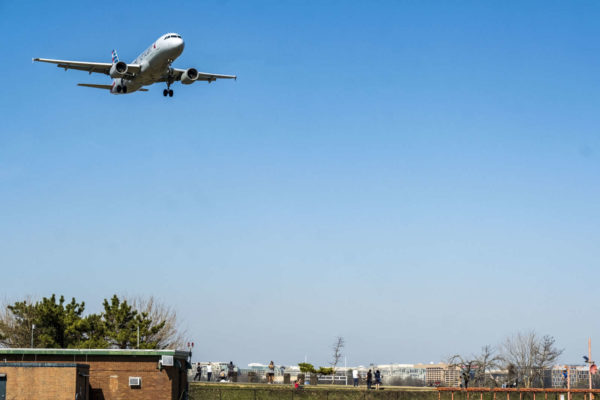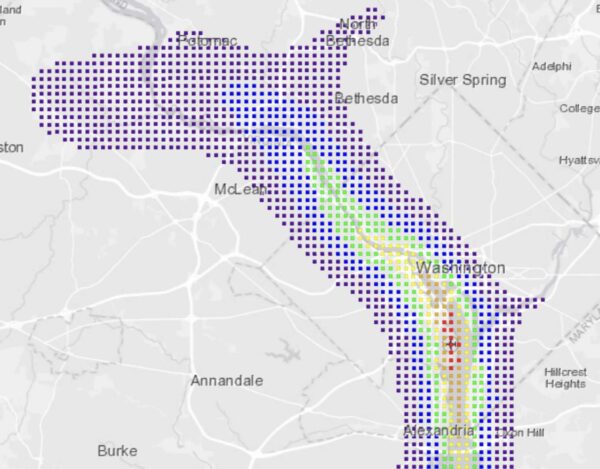
(Updated, 4:05 p.m.) As a new aircraft noise study comes in for a landing, Arlington officials admit there remains little the county can actually do about the noise above.
“I know how frustrating this is. I think people don’t understand how little power we actually have,” says Arlington County Board member Libby Garvey. “We really have almost zip.”
They’re not hopeful they can get the Federal Aviation Administration on board with changes, such as shifting National Airport’s flight patterns to less populated areas. A work group plans to ask the agency to shift incoming planes away from more developed areas and is expected to recommend doing the same for departures.
For years, residents have complained about aircraft noise, resulting from the flight patterns in and out of National Airport as well as Pentagon-bound helicopters. It’s gotten marginally worse in recent years after the FAA adjusted flight patterns to push flight paths further west, away from D.C., due to the Secret Service’s concerns about commercial flights encroaching into federal no-fly zones (Prohibited Area 56). The new patterns resulted in complaints among Arlington residents who live close to the Potomac River, including those in Rosslyn.
In 2019, the Arlington County Board sent a letter to the FAA expressing its “strong opposition” to the changes while accusing the federal agency of not engaging with the community and doing something that is “quite possibly in violation of federal law.”
“Aircraft noise is a real thing,” Arlington County Board Member Takis Karantonis tells ARLnow. “It’s a quality of life issue for many Arlingtonians who live under or near flight paths.”

In May 2019, Arlington agreed to jointly fund a study with Montgomery County that would recommend to the FAA ways to reduce aviation noise and limit the impact on residents.
Now, after nearly three years, the “Aircraft Noise Mitigation Study” is reaching its conclusion.
The biggest takeaway is that the study recommends diverting flight paths in and out of National Airport so that fewer people are living directly under them. That means prioritizing noise reduction in more dense and populated areas, as well as “noise sensitive residential areas,” to the extent possible. The study also looked at how takeoff speed, trajectory, and height impact noise.
Last summer, new flight paths for incoming flights were proposed and, just this past December, departing flights were discussed. In addition to shifting paths, a recommendation was made for departures to be split into multiple segments so that there would be a “more equitable distribution of noise.”
The incoming flight paths were approved by DCA Community Working Group, which operates under the Metropolitan Washington Airports Authority (MWAA), and the departure paths will be reviewed in April.
It’s expected those recommendations, with possibly a few tweaks, will be approved and proposed to the FAA. But officials are skeptical of whether the FAA and federal agencies take them into consideration.
“Arlington County against the federal government is kind of a little unbalanced in terms of a power setup,” Garvey said, echoing what she said at last week’s recessed Board meeting.
That’s one of the reasons Arlington partnered with Montgomery County on the aircraft noise study, so that two jurisdictions could come together with credible data to ask the FAA and Secret Service to make changes.
The counties are also in talks with D.C. and other local jurisdictions to apply more pressure to the federal agencies. But she understands why some residents may feel like just doing a study is not enough.
“Our residents who are frustrated with the noise see nothing [being done] and they’d like us to sue the FAA or something like that,” says Garvey. “I understand the desire to do that, but that actually would be very counterproductive and not actually get us anywhere.”
So far, the FAA hasn’t committed to when or even if they’ll take any of the recommendations in regards to National Airport made by the counties and the working group.
In response to an inquiry from ARLnow about the recommendations and about the expansion of the no-fly zone, the FAA provided this statement:
The FAA received the DCA Community Working Group’s Recommendation #22, which is specific to arrivals on Runways 15/19. We are working to finalize the proposal to comply with FAA design and safety criteria, and anticipate a final design soon. We will review any future recommendations for departure path changes.
Not all Arlingtonians were thrilled with the study’s recommendations. Some residents have argued that the recommendations would disproportionately impact single-family-home neighborhoods closer to the river, like Chain Bridge Forest and Arlingwood, while benefiting neighborhoods on the other side of the river.
“To be clear, this [plan] means that neighborhoods like Chain Bridge Forest and Arlingwood that sit near the Chain Bridge not only see zero relief from airplane noise, we will now see and hear even more flights overhead,” one such resident said at a September County Board meeting. “The flight disturbance over our homes is almost constant with occasional periods of relief. Under this plan, those much needed moments of noise relief will disappear.”
It’s unlikely that there’s a plan that would appease everyone. The flight path north of DCA largely follows the Potomac, and even small tweaks result in more noise — and more complaints — somewhere. Short of reducing the number of flights arriving and and departing the recently-expanded airport, something that is highly unlikely to happen, the battle over aircraft noise seems to largely be a tug-of-war, despite the cross-jurisdictional cooperation between Arlington and Montgomery counties.
Karantonis says he understands the concerns of Chain Bridge Forest and Arlingwood residents, but the fact of the matter is that fewer people live in those neighborhoods, as opposed to Rosslyn, Ballston or other more populated places, which are prioritized under the plan. Still, he said, the plan’s recommendations are better than nothing.
“Even for the less populated areas, any improvement is an improvement for them too,” Karantonis says.

